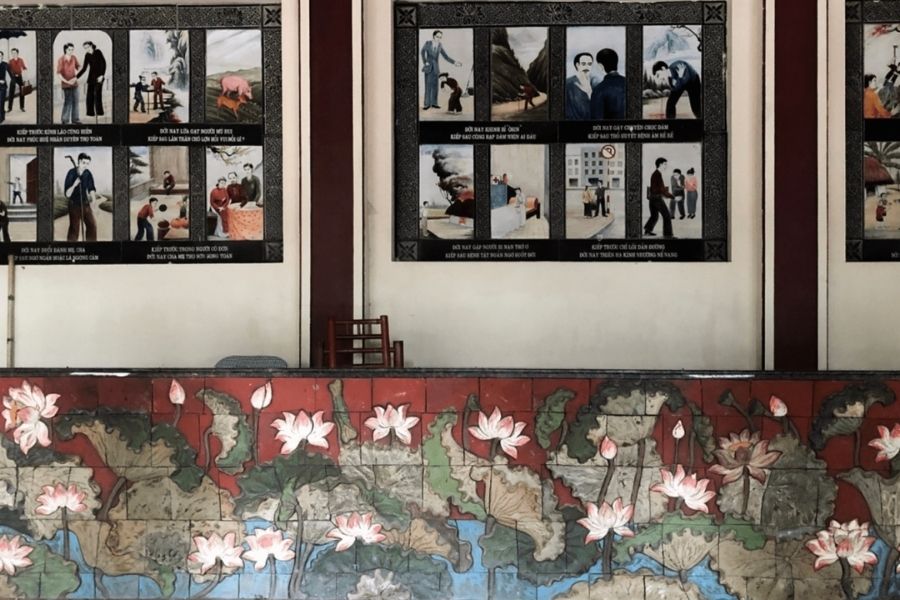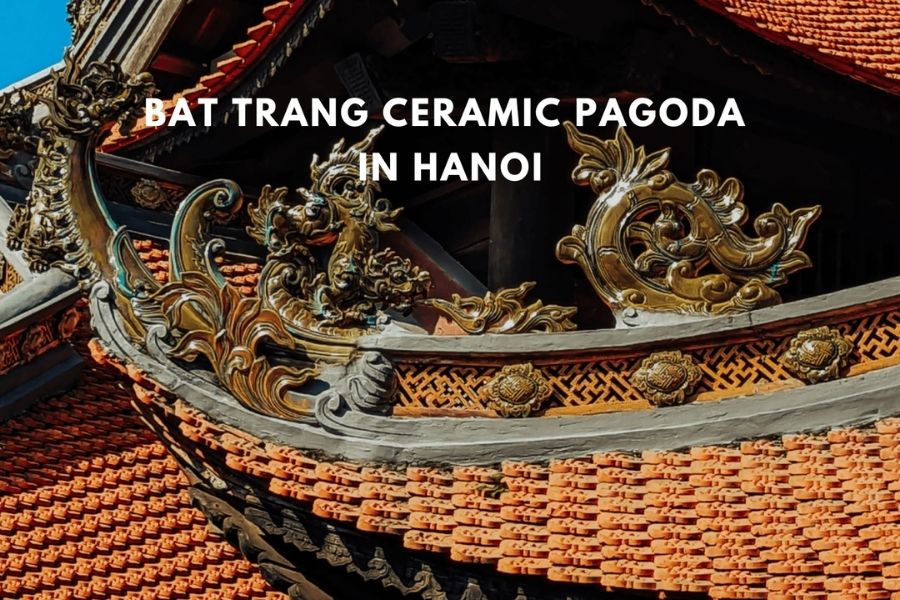Many details in the Bat Trang Ceramic Pagoda are adorned with ceramic pottery, showcasing the essence of the traditional Bat Trang village craftsmanship in Hanoi.
Located in Giang Cao village, Bat Trang commune, Gia Lam district, Hanoi, an area known for its famous ceramic pottery, the Bat Trang Ceramic Pagoda was constructed during the Tran Dynasty period (1226-1400). The pagoda has undergone several renovations and restorations and currently covers an area of approximately 8,300 square meters, according to the Thon Giang Cao Heritage Management Subcommittee.

After enduring the ravages of war and periods of neglect, the pagoda underwent restoration in 2011. Since then, the exquisite ceramic pottery products from Bat Trang village have gradually found their way into the interior and exterior spaces of the pagoda.
Local artisans have meticulously crafted and designed the pagoda’s entrance gate, using small pieces of ceramic pottery to create a unique appearance.
Upon passing through the pagoda gate and entering the main courtyard, you’ll find two pavilions dedicated to the Eighteen Arhats. Each pavilion houses 9 statues, set against a backdrop of cloud and mountain paintings, covering an area of about 60 square meters. These statues, wall paintings, and altar borders are all made and assembled from ceramic pottery.
Outside the Eighteen Arhats pavilions, the columns are adorned with intricate patterns of green ceramic dragons, elegantly coiled around the pillars.
From the central courtyard, a path leads to the main hall of the Three Jewels Pagoda. A mural in the Om Mani style (a sacred mantra in Tibetan Buddhism) made from multi-colored ceramic pottery pieces is one of the pagoda’s unique artworks. This mural measures approximately 2×2 meters and is placed on a threshold also adorned with green ceramic pottery pieces.

The Three Jewels Pagoda is decorated with ceramic motifs in the three primary colors of green, red, and gold. The columns feature ceramic paintings of lotus flowers, chrysanthemums, and bamboo, which are common motifs in Vietnamese Buddhist architecture.
In the main hall of the Three Jewels Pagoda, there are two large ceramic statues of Dharma protectors, each standing at a height of 2.5 meters. These statues, cast in a single piece of ceramic, took over a year to complete. They represent unique masterpieces, adding distinctiveness to the pagoda and showcasing the craftsmanship of Bat Trang artisans.

The first casting of these Dharma protector statues was marred by deformities, fractures, and cracks in some details due to the extreme heat of the kiln, which exceeded 1,000 degrees Celsius. Consequently, they had to be remade, consuming a considerable amount of time, effort, and financial resources, as explained by Truong Thuy Thanh (Dharma name Hanh Lien), who oversees the pagoda’s spiritual activities.
Behind the main hall of the Three Jewels Pagoda is the Ancestral Hall, which features four dragon statues from the Le Dynasty placed on the doorstep. The primary material used for decorating the Ancestral Hall is ceramic, predominantly in the color of wingspan feathers.
Inside the hall, there are 9 ceramic statues. In the center of the altar, there is a statue of Emperor Tran Nhan Tong. On the altar, there are also two vases of blessings (vases with child figurines, symbolizing blessings), also made from ceramic, offered by the people of Bat Trang village.

In the waiting area, there are five ceramic paintings depicting the law of karma (above) and a lotus pond painting exuding an ancient and elegant beauty, assembled from numerous ceramic pieces (below).
All the roof ridges of the pagoda are made of ceramic, featuring carvings of dragons and sunflower patterns below. Inside the pagoda, there are numerous ceramic statues of dragons, mythical unicorns, fish, and large statues depicting the daily activities of enlightened beings, all crafted from ceramic pottery.
Thich Bao Duc, the abbot of the Bat Trang Ceramic Pagoda since 2013, has contributed significantly to transforming the pagoda into a “craft village museum.” Based on his vision, local residents have contributed their expertise, techniques, and funds to design and complete each structure. Today, the pagoda houses nearly 80 ceramic statues, in addition to wall paintings, decorative motifs, and miniature scenes depicting the daily lives of enlightened beings.
